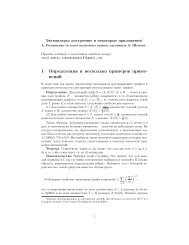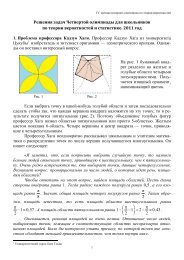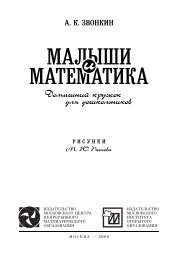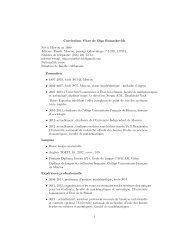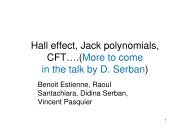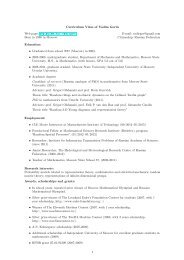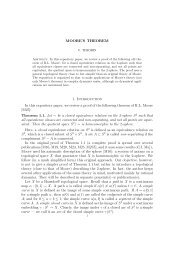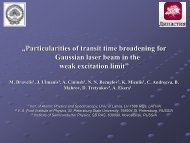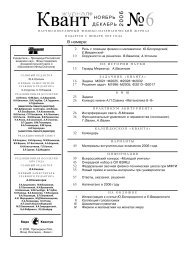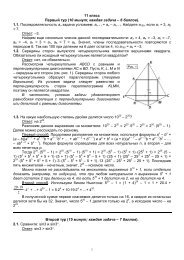a gauss-bonnet theorem, chern classes and an adjunction formula
a gauss-bonnet theorem, chern classes and an adjunction formula
a gauss-bonnet theorem, chern classes and an adjunction formula
Create successful ePaper yourself
Turn your PDF publications into a flip-book with our unique Google optimized e-Paper software.
2<br />
Theorem 1.1. [26] If F is equivari<strong>an</strong>t under the adjoint action of G, then its Euler<br />
characteristic c<strong>an</strong> be computed in terms of its characteristic cycle ∑ c α T ∗ X α<br />
G by the<br />
following <strong>formula</strong><br />
χ(G, F) = ∑ c α gdeg(X α ),<br />
where coefficients c α are the multiplicities of the characteristic cycle.<br />
In other words, the Euler characteristic of a sheaf is equal to the intersection<br />
index of the characteristic cycle with the graph of a generic left-invari<strong>an</strong>t 1-form on<br />
the group G. The Gauss map provides a definition of such intersection index in the<br />
noncompact situation. In this form, Theorem 1.1 is very similar to the well-known<br />
Kashiwara’s index <strong>theorem</strong>, which holds for compact m<strong>an</strong>ifolds.<br />
Theorem 1.1 relates two geometric invari<strong>an</strong>ts of a sheaf: the Euler characteristic<br />
<strong><strong>an</strong>d</strong> the characteristic cycle. In some cases this relation c<strong>an</strong> be used to estimate one<br />
of these invari<strong>an</strong>ts if the other is known (see Corollary 1.3). This works especially<br />
well if the sheaf F is perverse (see Corollary 1.2). In this case the multiplicities c α of<br />
the characteristic cycle are nonnegative.<br />
Theorem 1.1 gives a tool to classify adjoint equivari<strong>an</strong>t perverse sheaves with a<br />
given Euler characteristic. E.g. if the Euler characteristic is small then the characteristic<br />
cycle c<strong>an</strong>not have components with large Gaussi<strong>an</strong> degrees. This gives some<br />
essential restrictions on the characteristic cycle. One of my future pl<strong>an</strong>s is to explore<br />
the geometry of subvarieties with a given Gaussi<strong>an</strong> degree <strong><strong>an</strong>d</strong> to give a geometric<br />
description of perverse sheaves with a given Euler characteristic. I am especially<br />
interested in perverse sheaves with Euler characteristic 1. When G is a complex<br />
torus such sheaves (if irreducible) are identified with complexes of solutions of the<br />
generalized hypergeometric systems [11]. Irreducible hypersurfaces in (C ∗ ) n of the<br />
Gaussi<strong>an</strong> degree 1 are identified with discrimin<strong>an</strong>tal hypersurfaces of the generalized<br />
hypergeometric functions [19].




